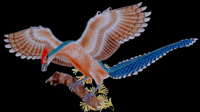
A reconstruction of Jeholornis prima
The lacustrine deposits in the Early Cretaceous Jehol Group in northeast China's Liaoning area is a treasure house for paleontological studies. Recently, CAS scientists made new significant discoveries there: fossils of a new avian species.
The fossils belonged to a long-tailed, seed-eating bird from the Early Cretaceous, asserts Prof. Zhou Zhonghe and Zhang Fucheng in a report appeared in the July 25 issue of
Nature.
The new species (
Jeholornis prima) should be the earliest Mesozoic bird ever found in China, only next to the world-famous
Archaeopteryx unearthed from Germany in 1861, according Zhou and Zhang, both from the CAS Institute of Vertebrate Paleontology and Paleoanthropology in Beijing. In comparison with Confuciusornis, another primitive bird excavated from western Liaoning area,
Jeholornis shows more primitive characteristics, representing a more ancient type in the history of the bird's early evolution.
The discovery provides new evidence for the hypothesis that birds came from dinosaurs. This bird is distinctively different from other known birds of the Early Cretaceous period in retaining a long skeletal tail composed of more than a score of caudal vertebrae. At the rear of modern birds, however, the number of caudal vertebrae is quite few, and the last ones are always fused into a tail cone called pygostyle, to which the buttock feather is attached. So is the case for the overwhelming majority of avian fossils hitherto known to us with the only exception of Archaeopteryx, whose fossilized skeleton has a set of complete and well-preserved caudal vertebrae but without pygostyle. Next to its German cousin, what Jeholornis now brought to light is a new species of primitive birds with an eye-catching complete slender tail but without a pygostyle.
Just like
Archaeopteryx, the new avian species becomes a transitional type between the reptile and bird as a convincing evidence for the biological evolutionism. In comparison with the oldest known species of the bird, i.e.
Archaeopteryx,
Jeholornis has more powerful flying ability. It also shared with Dromaeosaurs elongated chevrons and prezagopophysis in the caudal vertebrae. Besides, the Jehol bird was noted for its extremely developed second pedal claw on its feet. This feature is quite alien to other birds but is another similarity commonly shared by some dinosaurs such as dromaeosaurs and troodotids. In recent years, many feathered dinosaurs had been recovered in western Liaoning Province to support the hypothesis that avian species originated from dinosaurs. The discovery of the Jehol bird provides the first irrefutable evidence supporting the hypothesis from the side of avian fossils.
Another significance of the discovery is the fossilized seeds found in the avian stomach. This means that the bird was fed on plant seeds. In the past, there were many fossils of primitive birds reported but few had anything to do with their feeding habits as direct evidence. The well-preserved plant seeds in the body of a Mesozoic bird are the first report of this kind in the world. Among the hundreds of avian fossil specimens ever excavated from China, this is the first sample with direct evidence about the bird's feeding content. Although the bird's teeth are found having gone through a long way of degeneration, its upper and lower jaws are robust and well-developed. Scientists believe this resulted from the adaptation to its feeding habit. Other interesting phenomena are the extensive and massive distribution of the seeds and their well-preserved state as most of the seeds still have their smooth and intact surface. From these facts, scientists speculate the bird must have a well-developed and capacious crop in charge of food storage and digestion. What still puzzles scientists is the taxonomic affiliation of the seeds. Palaeo-botanists say they don't know whether they belong to angiosperm or gymnosperm plants. But one thing is certain, they believe, with more complete specimens of Mesozoic plants to be brought to light in the future, the puzzle will certainly demystified. (Zhao Baohua & Guo Haiyan)





